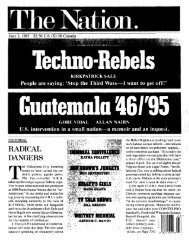Divergent Trajectories: Healthcare Insurance Reforms in East Asia ...
Divergent Trajectories: Healthcare Insurance Reforms in East Asia ...
Divergent Trajectories: Healthcare Insurance Reforms in East Asia ...
Create successful ePaper yourself
Turn your PDF publications into a flip-book with our unique Google optimized e-Paper software.
Illan Nam, Colgate University, Feb 2011Draft <strong>in</strong> progress, please do not quote or citecontracts. Somewhat surpris<strong>in</strong>gly, these adjustment strategies affected not only unskilledand skilled manual workers but also white-collar workers. In countries such as SouthKorea and Taiwan, where the developmental state’s growth strategy rested upon thecultivation of more value-added, skilled manufactur<strong>in</strong>g <strong>in</strong>dustries, <strong>in</strong>creased trade<strong>in</strong>tegration heightened vulnerabilities for not only work<strong>in</strong>g class but also white-collarworkers. This reflected the fact that export-oriented <strong>in</strong>dustrialization, a cornerstone ofthe <strong>East</strong> <strong>Asia</strong>n states’ developmental paradigm, was underp<strong>in</strong>ned by not only a large poolof skilled and semi-skilled labor but also by skilled adm<strong>in</strong>istrative and service-basedfunctions that composed a wide spectrum of white-collar jobs that supported these export<strong>in</strong>dustries.Thus, labor market flexibilization <strong>in</strong>creased employment precariousness for bothformal and <strong>in</strong>formal sector workers. Yet, the former’s proclivities for recogniz<strong>in</strong>g thisshared <strong>in</strong>security depended not merely upon the fact but also upon how levels of<strong>in</strong>equality mediated their perceptions of the boundaries between themselves and <strong>in</strong>formalworkers. I argue that <strong>in</strong> more equal societies, a rise <strong>in</strong> labor market <strong>in</strong>securityaccentuated the formal sector’s perception that the boundary between themselves and<strong>in</strong>formal sector workers was relatively permeable. Because the disparity <strong>in</strong> educationaland professional qualifications between formal and <strong>in</strong>formal sector workers is muchnarrower <strong>in</strong> more equal countries, privileged workers are less likely to dist<strong>in</strong>guish ayawn<strong>in</strong>g distance between themselves and <strong>in</strong>formal sector workers as well as more likelyto perceive a greater personal stake <strong>in</strong> redress<strong>in</strong>g the <strong>in</strong>equities <strong>in</strong>herent <strong>in</strong> the healthcaresystem that discrim<strong>in</strong>ated aga<strong>in</strong>st <strong>in</strong>formal workers. Thus, these calculations are moreconducive to their recognition of a shared <strong>in</strong>terest <strong>in</strong> more solidaristic healthcare and their27













